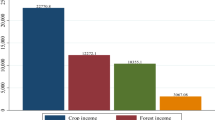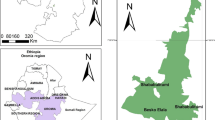Abstract
Changes in the economic environment, including increased international competition caused by globalisation, low-priced imports and high costs of labour, are influencing the economic situation of all agricultural enterprises, and naturally including those on forest land. As a result, changes are taking place in the structure of agricultural enterprises, with smaller units disappearing. Enterprises with greater areas of agricultural and forest land strive to expand by purchasing or leasing more agricultural area or forests, depending on their labour and financial resources. Another way to overcome the economic needs and to survive as a family enterprise in the future is to find new sources of income. In a case study in the Southern Black Forest an investigation of 32 family-enterprises with agricultural and forest land and members of an accounting network was carried out in order to register all types of income of the family which contribute economically to their costs of living. Besides the traditional income from agriculture and forestry, income was found to be derived from renting rooms or flats for holiday-makers, employment outside the enterprise, contract-working,a nd direct-marketing of own products. This paper presents the results of the study, showing the overall distribution of the total income of the family to the various types of activities of the family. On average, agriculture, forestry and the other income sources are found to each contribute about one third to overall income. The great variety of income combinations are illustrated in diagrams and clustered to different types of organization of family-farm enterprise. It is also notable that the amount of the total income varies from very high to very low between individual enterprises.
Similar content being viewed by others
References
Brandl, H. and Schanz, H. (1992), Wandel und Tendenzen in der Betriebsgrößenstruktur des Privatwaldes Baden-Württemberg, AFZ, 705–708.
Brandl, H. (1998), Zur regionalwirtschaftlichen Bedeutung der Forstwirtschaft im Schwarzwald, in W. Sekot, Hg., Beiträge zur Forstökonomik, Festschrift für Univ.-Prof. Dr. Wolfgang Sagl, Schriftenreihe des Instituts für Sozioökonomie der Forst- und Holzwirtschaft, Band 31, Universität für Bodenkultur Wien.
Nain, W. (1998), Methodological Issues of Cost Accountancy in Farm Forest Enterprises. MOSEFA-Workshop A 28.-31.8.1997, EFI Proceedings No. 20, Joensuu.
Brandl, H., Hercher, W., Löbell, E., Nain, W., Olischläger, T. and Wicht-Lückge, G. (1999), 20 Jahre Testbetriebsnetz Kleinprivatwald in Baden-Württemberg, Betriebswirtschaftliche Ergebnisse 1979–1998, Mittlg. der Forstlichen Versuchs- und Forschungsanstalt Baden-Württember, Freiburg, Heft 14.
Brandl, H., Nain, W. (1999), Cost Accountancy Network in Farm Forest Enterprises in Baden-Württemberg. In EFI Proceedings No. 31, European Forest Instute, Joensuu, Finland.
Niskanen, A. and Hyttinen, P., eds. (1999), Prospects of International Statistics on Farm Forestry Mosefa Concerted Action Project (FAIR-CT 96-1414), European Forest Institute Proceedings No. 31, Joensuu.
Brandl, H. (2000), Untersuchungen zur Einkommensstruktur gemischter land- und forstwirtschaftlicher Betriebe im Südschwarzwald. Vortrag bei der Forstwissenschaftlichen Tagung 2000 in Freiburg.
Niskanen, A. and Sekot, W., eds. (2001), Guidelines for Establishing Farm Forestry Accountancy Networks. MOSEFA (Monitoring the Socio-Economic Situation of European Farm Forestry) European Forest Institute Research Report 12, Leiden, Boston, Köln.
Brandl, H. (2001), Bäuerlicher Waldbesitz in Baden-Württemberg. Verbreitung und wirtschaftliche Bedeutung. Der Bürger im Staat, 51. Jg., Heft 1, 59–66.
Author information
Authors and Affiliations
Rights and permissions
About this article
Cite this article
Brandl, H. The economic situation of family-farm enterprises in the southern black forest. Small-scale Forestry 1, 13–24 (2002). https://doi.org/10.1007/s11842-002-0002-2
Issue Date:
DOI: https://doi.org/10.1007/s11842-002-0002-2




